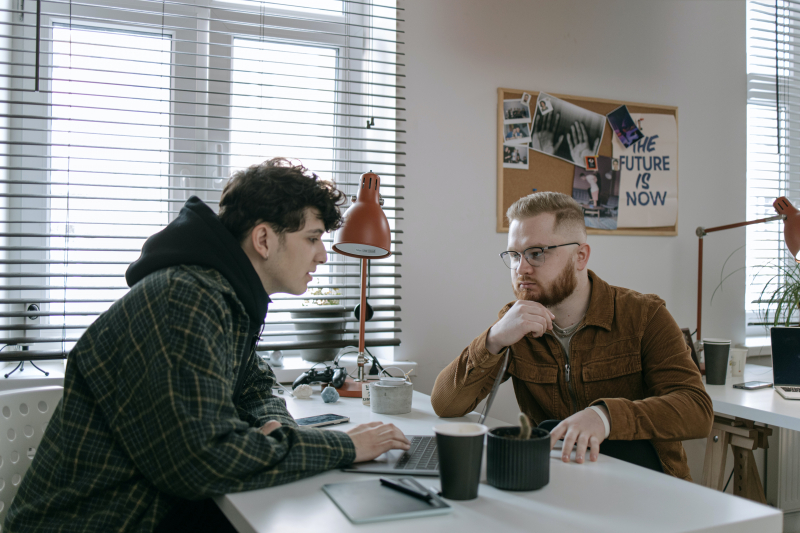Top 16 Most Asked Art Teacher Interview Questions with Answers
Congratulations on being called in for an interview as an art teacher! Your job as an art teacher will be to teach your students about the history of art and ... read more...how to create it. But you feel nervous as you walk into the interview. Here are some of the most asked art teacher interview questions with answers.
-
This question may be asked by an interviewer to assess your understanding of the value of art education and how it fits into a standard school curriculum. Try to express your passion for art in your response, as well as why teaching art is important to you and how art instruction can benefit students in the long run.
When answering questions designed to elicit your opinion, it is best to be as thorough as possible. Perhaps you see art as a way for children to stimulate their imaginations while also allowing them to express themselves. Inform them about how you can develop a child's talent and creativity. Art also requires concentration, which helps students focus better in their daily activities. These questions should be answered with a personal touch, avoiding generalization.
Answer as an example: "Art instruction, in my opinion, is an essential component of any curriculum. Some educators believe that art education is less important than traditional core subjects like mathematics, language arts, and science, but I believe that art often stimulates a different type of student growth than other classes. For example, as an art teacher, I create a space in my classroom for students to explore their creativity, express themselves, understand their identities, and connect deeply with their communities."

Image by Mike Jones via pexels.com 
Image by Vlada Karpovich via pexels.com -
Maintaining consistent and respectful communication with students' parents and guardians is an essential part of being a teacher. Most teachers must also be able to effectively navigate challenges related to student performance and behavior. As a result, an interviewer may ask you this question to assess your preparedness for such situations. Describe your approach to sensitive communication, parent-teacher collaboration, and student support in your response.
This is a situational question where the employer wants you to use your previous experience as well as your communication skills to be able to talk to parents about their child's learning. For many parents, they will not completely agree about their child's academic performance, so the behavior of an art teacher is one of the best ways to explain to them about their child. Since then, both sides seek to improve and practice so that students can improve.
Answer as an example: "If a student consistently underperformed in my class, I would notify their parents or guardians of the pattern I was noticing. I would ask the student's guardian if they are having any personal difficulties that are affecting their performance, offer advice for supporting their student, and provide strategies for their student to progress in my course. In situations like this, I believe it is critical to act empathetically and collaborate with guardians to help identify pathways for student success."

Image by fauxels via pexels.com 
Image by fauxels via pexels.com -
Have you ever imagined how an angry parent would create a sense of inhibition for teachers and principals? When confronted with them, don't think about the reasons why they are angry. Just focus on tips like listening and understanding, problem analysis, showing empathy, etc to cope. Then you will be able to calm them down.
An interviewer may ask you this question to gauge how you would handle conflict as an art teacher. While parent-teacher conflict is unlikely in your teaching career, it does occur and can be difficult to manage. Describe how you would respond to a parent's complaint while remaining professional, and detail the steps you would take to resolve this issue in your response.
Answer as an example: "I would be hurt if a parent complained to administrators about my class, but I would maintain my professionalism regardless of my personal feelings." I understand how important it is to respect parents' opinions and make them feel at ease with their child's education. In this case, I'd offer to sit with the parent and listen to their complaints firsthand, solicit any suggestions for improvement, and collaborate with them to brainstorm ideas for managing my classroom in a way that meets their needs.

Image by Ketut Subiyanto via pexels.com 
Image by Yan Krukau via pexels.com -
There are two general approaches to learning in the classroom: other-directed learning and self-directed learning. Other-directed learning is the traditional method of instruction in which a teacher leads the lesson and students are more passive in their listening and taking notes. It is the method with which teachers are most at ease because they have complete control over what is taught and, in most cases, how students learn. However, self-directed learning became a major educational movement around 1975, and it is proving to be a strategic instructional approach.
SDL involves students taking ownership of their education and working independently to understand their needs, set goals, find resources, and implement learning strategies. Because SDL is commonly used in art education, an interviewer may ask you this question to learn more about how you encourage it in your classroom and whether your approach has been successful. Describe strategies you use to foster a classroom environment that encourages independent learning in your response.
Answer as an example: "As an art teacher, I believe it is critical to assist students in discovering new information on their own and engaging in critical thinking processes. As a result, in my classroom, students complete a variety of self-directed tasks and projects that include goal-setting and learning activities that are relevant to their educational needs and life experiences. These tasks and projects lead up to a final portfolio project in which students create a gallery of their work and demonstrate their ability to self-direct and self-contextualize their learning."

Image by Yan Krukau via pexels.com 
Image by Tima Miroshnichenko via pexels.com -
As the teacher in your classroom, you have the authority to establish expectations. If you establish a positive teacher-student relationship and set high expectations, your classroom will follow suit and become a positive and supportive environment filled with motivated students. Teachers who assist their students in their learning environment can have a positive impact on their social and academic outcomes, which is critical for the long-term trajectory of school and, eventually, employment.
Students' motivation and desire to learn are linked to academic improvement and a positive teacher-student relationship. Students who perceive a positive, warm, and close relationship with their teacher are motivated to be more engaged in school and to improve their academic achievement.When compared to teachers of other disciplines such as math, language arts, and science, art teachers frequently play a unique role in student development. This question may be asked by an interviewer to assess your ability to support students and foster positive relationships with them. Describe your approach in your response, including how you make students feel at ease in your classroom and encourage them to stretch themselves.
Answer as an example: "Whenever I teach a new group of students, I work with them to establish ground rules for our classroom environment and allow them to contribute any rules they believe are necessary to maintain comfort and respect." This, I believe, helps us begin our time together with a shared understanding of how our relationships will function. From here, I try to create a trusting environment." I always encourage my students to contact me if they need to talk or need additional assistance. More importantly, I try to make my classroom a place where challenging ourselves is the norm and making mistakes is perfectly acceptable—even encouraged."

Image by Canva Studio via pexels.com 
Image by fauxels via pexels.com -
There are several reasons why an interviewer might inquire about an art teacher's creative process. To begin, the interviewer may be curious about how the art teacher plans and executes her lessons. An art teacher must have a well-organized and efficient creative process in order to make the most of the time they have with their students. Second, the interviewer may be curious about how the art teacher creates their own artwork.
Art teachers must have a strong creative process in order to produce high-quality artworks that inspire and engage their students. Finally, the interviewer may be curious about how the art teacher uses creativity to solve problems in the classroom. An art teacher must be able to think outside the box and devise creative solutions to problems in order for their students to learn and grow in a safe and supportive environment.
Answer as an example: "My creative process usually begins with a lot of brainstorming and research," for example. Before I begin creating anything, I like to gather as much information and inspiration as possible. I begin sketching out ideas once I have a good idea of what I want to create. From there, I begin to refine my ideas and create a more concrete plan. I start working on the actual piece, whether it's a painting, sculpture, or whatever, once I have a plan. I constantly evaluate my work and make adjustments as needed throughout the process."

Image by Edmond Dantès via pexels.com 
Image by Mikael Blomkvist via pexels.com -
An interviewer may ask this question to an art teacher for a variety of reasons. For starters, they may be attempting to determine how the art teacher views failure and whether it is a necessary part of the creative process. Second, the interviewer may be curious about how the art teacher uses failure to inform and improve their teaching techniques. Finally, the interviewer may be interested in learning how art teachers help their students deal with failure constructively.
It is critical for an art teacher to have a positive attitude toward failure because it is unavoidable that their students will fail at some point during their time in the class. An Art teacher must also be able to use failure as a learning tool, both for themselves and their students. The art teacher can foster a more positive and productive learning environment by helping their students understand that failure is a normal and necessary part of the creative process.
Answer as an example: "There is no such thing as failure; only feedback," for example. I am constantly experimenting and trying new things in my creative process. If something doesn't work out, I just take it as feedback to improve my work. I'm constantly learning from my mistakes and applying what I've learned to become a better artist."

Image by Kampus Production via pexels.com 
Image by Kampus Production via pexels.com -
Art teachers play an important role in guiding students through the process of self-expression and relating to their surroundings. Working as an art teacher can thus be a rewarding endeavor in which professionals can inspire students and help them hone their creative skills. If you're a prospective art teacher preparing for an interview, reviewing the questions that hiring managers frequently ask candidates may be beneficial.
This is an opportunity to demonstrate your enthusiasm for both art and teaching. Schools are realistic about budgetary concerns for the arts, but they also want to be sensitive to student needs and parent requests with the classes they offer. They want to make certain that every teacher is fully committed to their assigned program and enjoys what they do. Prepare to discuss what drew you to art in the first place, or when you decided to become a teacher. Stories like this will demonstrate your dedication to your craft and to your students
.
Answer as an example: I became interested in art as a child and took every available elective in high school. I accepted a scholarship to an art institute after working as a freelance artist right after high school. While I was there, I did an internship at a local high school, which inspired me to teach art to children.
After finishing art school, I researched the credentials needed to teach high school students and decided to further my education. I've tried to teach others in any way I can as I've continued to develop my own craft - I believe it's critical to train the next generation of artists.

Image by Gustavo Fring via pexels.com 
Image by Thirdman via pexels.com -
Children are naturally drawn to activities such as pantomime and clay sculpting. Arts-based learning capitalizes on their natural tendencies to maximize their creativity. However, when it comes to integrating the arts into other subjects, teachers frequently underestimate the power of such activities.
The reality is that "traditional" subjects such as English, math, history, and sciences are given higher priority by school administration because they are covered in standardized tests and are more directly related to success in a college degree. Art is typically offered as an elective rather than as part of the core curriculum, and it is not always available in college, except at specialized institutions. Using art to connect to other classes and subjects demonstrates that your teaching methods are innovative and support student learning in other areas. It also demonstrates how art can be used to reinforce lessons learned in other subjects.
Answer as an example: I make an effort to collaborate with other teachers to determine some aspects of my coursework. If the English teacher has a book report due, I might assign a painting inspired by the book they are reading. Alternatively, I may work with the history teacher to have my students create a scale diorama of the chapter they are studying that week. I try to make connections to their other studies to reinforce what they are learning, or at the very least to show that art can stand on its own and support other areas of their life.

Image by Diva Plavalaguna via pexels.com 
Image by Darlene Alderson via pexels.com -
Because creating is so personal, the answer to this question is also ultimately personal. It is an answer that art teachers must determine for themselves, lest it be influenced by the opinions or dictations of others. You are the artist, and the work is entirely yours. Having said that, determining whether or not your work is complete is clearly difficult. Self-doubt is present, and if you allow it, it will lead you down the path of overwork. Other factors, of course, are at work as well.
An interviewer might ask an art teacher, "How do you know when a piece of art is finished?" to get a sense of their teaching philosophy. Knowing when a piece of art is finished is important because it can help determine how much time and effort should be put into a project. It can also help keep unfinished projects from being abandoned.
Answer as an example: "There is no definitive answer to this question because it is up to the individual artist to determine when a work of art is complete." There are, however, some general guidelines to follow. A piece of art, for example, may be considered finished when the artist is satisfied with the results and believes they have successfully communicated their intended message or vision. Furthermore, a work of art may be considered finished when all of the elements are in place and the artist wishes to add or change nothing."

Image by Artem Podrez via pexels.com 
Image by Ivan Samkov via pexels.com -
Humans have been creative since the beginning of time, making art out of whatever materials were available. Art has always existed, from cavemen scratching crude drawings of animals into rocks to today's exciting and innovative modern artists. It is sometimes beautiful, sometimes captivating, sometimes telling a story, and sometimes provoking change. Whatever it's meaning and whatever the artist's intention, art is something tangible with an intangible sense of feeling attached to it, and that is something truly unique.
An interviewer might ask an art teacher, "How has your art practice changed over time?" to get a sense of the teacher's experience and how their teaching has changed and evolved over time. It is important to understand how an art teacher's practice has evolved over time because it can reveal the teacher's methods, philosophies, and overall approach to teaching art.
Answer as an example: "My art practice has evolved significantly over time." I was very focused when I first started out on trying to recreate what I saw in magazines and other artwork that I liked. I'd spend hours painstakingly copying images, and while I did end up with some nice pieces, it was extremely frustrating and didn't allow me to develop my own style.
I eventually began experimenting more and loosening up my approach. I gave myself permission to make mistakes and just have fun with it. As a result, my work became much more expressive and one-of-a-kind. I still enjoy trying new things and pushing myself creatively these days, but I'm much more confident in my abilities and at ease in my own skin.

Image by Pavel Danilyuk via pexel.com 
Image by Ivan Samkov via pexels.com -
You are ready to make your passion your full-time job after working a day job in an office, bar, coffee shop, or completely unrelated field. You've spent your evenings and weekends for years painting, sculpting, and dreaming late into the night. You know you're capable. You know that you have the vision. You have the motivation. You are aware that there will be long hours and that it will be difficult at first. You understand that this is all part of the process. You've read business books, saved money for your studio, and devised a strategy.
But you've never done anything like this before and have no idea what to expect. It is, after all, a leap of faith. An interviewer might ask an art teacher, "What are some of the most important lessons you've learned as an artist?" to get a sense of the teacher's experience and expertise. It is critical to understand what lessons an art teacher has learned because it can help determine how well they can teach students.Answer as an example: "Some of the most important lessons I've learned as an artist include never giving up on your dreams, never stopping learning and growing as an artist, and never being afraid to experiment." These lessons helped shape me into the artist I am today, and I am constantly striving to improve my abilities."

Image by Ivan Samkov via pexels.com 
Image by SHVETS production via pexels.com -
One of today's greatest challenges is that we frequently feel unaffected by the problems of others and global issues such as climate change, even when we could easily help. We do not believe strongly enough that we are members of a global community, of a larger we. Giving people access to data frequently leaves them feeling overwhelmed and disconnected, rather than empowered and ready to act. This is where art can have an impact. Art does not instruct people on what to do, but it can connect you to your senses, body, and mind. It has the ability to make the world feel. And this felt emotion may prompt thought, engagement, and even action.
An interviewer may ask an art teacher, "How has your work as an artist affected the way you see the world?" to gain insight into how the teacher's creative process and artistic outlook have shaped their perspective. This question can be useful in determining how art teacher approaches their subject matter and students, as well as whether their unique perspective can be beneficial in the classroom.
Answer as an example: "My work as an artist has undoubtedly influenced how I perceive the world." I look at the world through a more creative lens, and I'm always looking for new ways to express myself. I also perceive the world through the lenses of color, form, and composition. "I'm always looking for new color combinations and shapes to incorporate into my artwork."

Image by Tima Miroshnichenko via pexels.com 
Image by Pavel Danilyuk via pexels.com -
An interviewer might ask an arts professional, "How do you balance artistic expression with practical considerations?" because it is critical for artists to be able to strike a balance between creativity and practicality. An artist, for example, may need to compromise on their artistic vision in order to meet deadlines or budget constraints. It is critical for artists to find this balance because it allows them to continue creating without jeopardizing their livelihood.
The interviewer is attempting to assess the art teacher's ability to balance creativity and practicality. This is significant because it demonstrates whether the art teacher can adapt their teaching methods to meet the needs of their students. It also shows whether the art teacher is able to be flexible in their approach to teaching and whether they are able to find ways to help their students learn and grow while still allowing them to express their creativity.
Answer as an example: "When teaching art, it is critical to strike a balance between artistic expression and practical considerations." On the one hand, it is critical to encourage students to be expressive and creative. On the other hand, it is also important to teach them how to be practical and take into consideration the medium they are working with, the audience they are creating for, and the purpose of their art.”

Image by fauxels via pexels.com 
Image by Henri Mathieu-Saint-Laurent via pexels.com -
Isn't motivation difficult to come by? Some days you feel it, while others you can't even get a sliver of it no matter how hard you try. You stare at the computer screen, ready to type, create, and develop, but instead, you find yourself going through the motions, barely caring about the work you're producing. Needless to say, you're completely uninspired, and you have no idea how to change your mood.
The interviewer is attempting to assess the art teacher's level of dedication and enthusiasm for their position. It is critical to understand how motivated and inspired an art teachers is in their work because it can affect the quality of their instruction. If an art teacher is not motivated or inspired by their work, it will be evident in their interactions with students.
Answer as an example: "As an art teacher, there are a few things that keep me motivated and inspired. First and foremost, I enjoy watching my students progress and improve throughout the school year. It's so rewarding to see them improve their skills and gain confidence. Second, by taking classes, experimenting with new mediums, and attending exhibitions, I try to keep my own practice fresh. It is critical for me to stay current in order to share new ideas and techniques with my students. Finally, nature, books, music, and conversation provide me with inspiration. I’m always on the lookout for new sources of inspiration so that I can bring freshness and vitality to my teaching.”

Image by Pavel Danilyuk via pexels.com 
Image by Yan Krukau via pexels.com -
Consider working in the arts if you have a strong sense of creativity. The art industry offers numerous positions in various niches, which can assist you in finding a position that best suits your interests and abilities. Knowing how to find these positions can help you with your job search.
An interviewer may ask this question to an art teacher for a variety of reasons. For starters, it gives the interviewer a sense of the art teacher's experience and expertise in the field. Second, it enables the interviewer to gain an understanding of the art teacher's teaching philosophy. Finally, it allows the interviewer to determine whether the art teacher is enthusiastic about their work and whether they would be a good fit for the position.
Answer as an example: "There is no one-size-fits-all answer to this question, because the best advice for someone considering a career in art will vary depending on the individual's goals and interests." However, some general advice that anyone considering a career in art might find useful is to build a strong portfolio, get involved in the arts community, and network with other artists and professionals. It is also essential to be aware of the business side of the art world and to understand the fundamentals of marketing and selling artwork."

Image by RODNAE Productions via pexels.com 
Image by Mikhail Nilov via pexels.com





































